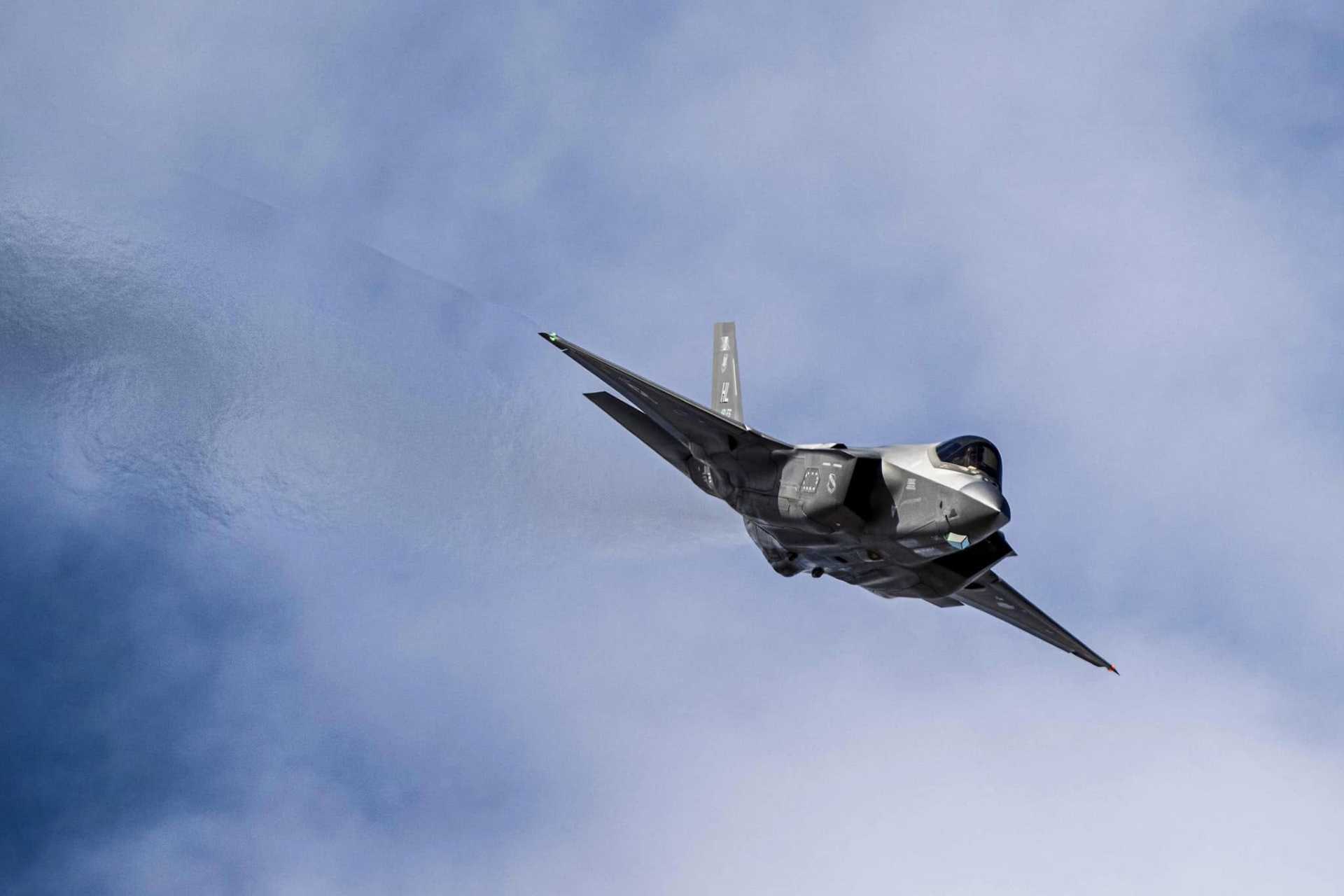Breaking News | Belgium could order up to 11 more F-35s assembled in Italy while waiting for European sixth-generation fighter jets

{loadposition bannertop}
{loadposition sidebarpub}
On April 23, 2025, Belgian Prime Minister Bart De Wever and Defense Minister Theo Francken confirmed that Belgium will acquire additional F-35 fighter jets, supplementing the 34 units already ordered under the initial 2018 contract. This official announcement marks a decisive reinforcement of Belgium’s alignment with the U.S.-led fifth-generation fighter program. According to Belgian media outlet RTL, the new procurement is expected to include 11 more aircraft. The decision was formally communicated during parliamentary sessions and comes in the context of an unprecedented increase in Belgium’s defense budget, designed to meet NATO requirements earlier than initially planned.Follow Army Recognition on Google News at this link
According to RTL, Belgium is rumored to order up to 11 additional F-35s, which would bring the total number of American fighter jets ordered to 45. (Picture source: Facebook/F-35 Demo Team)
The 2025 defense budget will be increased by €3.9 billion, enabling Belgium to reach the NATO spending benchmark of 2% of GDP four years ahead of the 2029 deadline. This funding effort was ratified as part of the Easter Agreement concluded by the federal government on April 11. However, the full allocation of the additional funds will not be revealed until July. While Defense Minister Francken has remained reserved about specifics, he acknowledged that this year’s defense funding will rely in part on extraordinary and temporary resources, including dividends from Belfius bank and proceeds from frozen Russian assets. Nevertheless, the long-term financing challenge remains. The upcoming NATO summit in The Hague in June could redefine expectations further, with possible targets of 3% to 5% of GDP being discussed.
In line with this accelerated financial commitment, Prime Minister De Wever emphasized that the only viable candidate for the new fighter jet procurement is the F-35, citing the existing fleet of 34 already integrated into Belgium’s planning and training. The argument was also framed in terms of urgency: Belgium needs these capabilities immediately, not decades from now. Francken echoed this point by explaining that while Belgium supports the sixth-generation European SCAF program, with a €60 million contribution already committed, its delivery timeline extends beyond 2040, rendering it irrelevant to current operational needs. Francken stressed that Belgium must remain operationally ready, while also keeping the door open for future participation in a top-tier European fighter project.
One of the key reasons offered by both political figures for continuing with the F-35 program was the possibility of shifting final assembly from the United States to Italy. Minister Francken confirmed that he had officially requested Italian Defense Minister Guido Crosetto to arrange for future Belgian F-35s to be assembled at the Cameri Final Assembly and Check-Out (FACO) facility in northern Italy. This move, he explained, would help align Belgium’s defense investment with European industrial and strategic goals, reduce reliance on the U.S. supply chain, and potentially create new jobs within Europe. However, it remains unclear whether aircraft assembled in Cameri would meet EU criteria to be considered “European,” which is key for Belgium to justify these acquisitions under European debt flexibility rules.
Francken has dismissed the ‘kill switch’ concerns as myths, asserting that Belgian-operated F-35s can function autonomously for extended periods and that logistical independence is built into the multinational support network. (Picture source: Facebook/F-35 Demo Team)
Belgium’s involvement in the F-35 program dates back to 2018, when then-Defense Minister Steven Vandeput signed a €3.6 billion contract for 34 F-35As, later adjusted to nearly €4 billion after infrastructure, maintenance, and training costs were included. The aircraft are replacing the Belgian Air Force’s fleet of F-16s, with 30 of the older jets planned for transfer to Ukraine starting in 2026. By early 2025, Belgium had taken delivery of eight F-35s, all stationed at Luke Air Force Base in Arizona for pilot and technician training. These are scheduled for transfer to Belgium in late 2025. In preparation, the Belgian government has allocated €275 million to modernize airbases in Florennes and Kleine-Brogel, including hangars, simulators, maintenance centers, and operational housing.
Economic returns from the F-35 program have been lower than initially projected. In 2018, it was announced that Belgian aerospace companies would benefit significantly from the procurement, but by 2022, only €700 million in contracts had been awarded. A revised 2024 agreement projected returns of €66 million annually over 40 years, totaling €2.7 billion, substantially less than the estimated €12.4 billion lifetime cost of the fleet. Nonetheless, both the government and military leadership have emphasized the program’s advanced state and current operational relevance, particularly in the context of NATO missions and the evolving threat environment. Belgium also recently purchased $115 million worth of GBU-53/B bombs for its F-35s.
Minister Francken has reaffirmed Belgium’s full commitment to the F-35 program despite past setbacks, including a temporary rejection of two aircraft in 2023 over software and display issues. He reiterated that Belgium’s air force is too small to maintain a second fighter type, meaning future acquisitions will remain within the F-35 framework. Additionally, he highlighted the need for stronger offset agreements and better integration of Belgian industries in future contracts, noting past underperformance in this area.
One of the key reasons offered by the Belgian Defense Minister for continuing with the F-35 program was the possibility of shifting final assembly from the United States to Italy, which would be considered European products under EU rules. (Picture source: Facebook/F-35 Demo Team)
Belgium’s strategic position within NATO, including hosting SHAPE and NCIA in Mons, further underscores its need for interoperable and modern defense systems. The choice to double down on the F-35, despite ongoing concerns about U.S. control over software and the hypothetical “kill switch”, reflects both military pragmatism and alliance obligations. Francken has dismissed these concerns as myths, asserting that Belgian-operated F-35s can function autonomously for extended periods and that logistical independence is built into the multinational support network.
The broader European context also plays a role. While other nations such as Portugal have expressed interest in alternatives like the Rafale or the Gripen, Belgium’s latest decision effectively rules out reconsideration of the French fighter. Prime Minister De Wever framed the F-35 as a multilateral project with significant European content, stressing that geopolitical tensions, including statements by Donald Trump, cannot reverse the economic and industrial integration embodied by the program. According to Deputy Prime Minister Kris Peeters, 30% of F-35 components are sourced from European suppliers, lending weight to the argument that the aircraft is not exclusively American in origin.
Belgium’s commitment to increasing defense spending does not stop at fighter jets. The broader defense investment strategy includes potential procurement of rocket launchers, tanks, and further infrastructure, with projections indicating more than €20 billion in additional spending over five years. Minister Francken has made clear that this is just the beginning. The upcoming NATO summit may well redefine the financial landscape for defense in Europe, pushing member states toward higher spending thresholds. For Belgium, the challenge will be to sustain this effort through a combination of national borrowing, EU flexibility rules, and strategic industrial alignments, starting with the F-35 and beyond.

{loadposition bannertop}
{loadposition sidebarpub}
On April 23, 2025, Belgian Prime Minister Bart De Wever and Defense Minister Theo Francken confirmed that Belgium will acquire additional F-35 fighter jets, supplementing the 34 units already ordered under the initial 2018 contract. This official announcement marks a decisive reinforcement of Belgium’s alignment with the U.S.-led fifth-generation fighter program. According to Belgian media outlet RTL, the new procurement is expected to include 11 more aircraft. The decision was formally communicated during parliamentary sessions and comes in the context of an unprecedented increase in Belgium’s defense budget, designed to meet NATO requirements earlier than initially planned.
Follow Army Recognition on Google News at this link
According to RTL, Belgium is rumored to order up to 11 additional F-35s, which would bring the total number of American fighter jets ordered to 45. (Picture source: Facebook/F-35 Demo Team)
The 2025 defense budget will be increased by €3.9 billion, enabling Belgium to reach the NATO spending benchmark of 2% of GDP four years ahead of the 2029 deadline. This funding effort was ratified as part of the Easter Agreement concluded by the federal government on April 11. However, the full allocation of the additional funds will not be revealed until July. While Defense Minister Francken has remained reserved about specifics, he acknowledged that this year’s defense funding will rely in part on extraordinary and temporary resources, including dividends from Belfius bank and proceeds from frozen Russian assets. Nevertheless, the long-term financing challenge remains. The upcoming NATO summit in The Hague in June could redefine expectations further, with possible targets of 3% to 5% of GDP being discussed.
In line with this accelerated financial commitment, Prime Minister De Wever emphasized that the only viable candidate for the new fighter jet procurement is the F-35, citing the existing fleet of 34 already integrated into Belgium’s planning and training. The argument was also framed in terms of urgency: Belgium needs these capabilities immediately, not decades from now. Francken echoed this point by explaining that while Belgium supports the sixth-generation European SCAF program, with a €60 million contribution already committed, its delivery timeline extends beyond 2040, rendering it irrelevant to current operational needs. Francken stressed that Belgium must remain operationally ready, while also keeping the door open for future participation in a top-tier European fighter project.
One of the key reasons offered by both political figures for continuing with the F-35 program was the possibility of shifting final assembly from the United States to Italy. Minister Francken confirmed that he had officially requested Italian Defense Minister Guido Crosetto to arrange for future Belgian F-35s to be assembled at the Cameri Final Assembly and Check-Out (FACO) facility in northern Italy. This move, he explained, would help align Belgium’s defense investment with European industrial and strategic goals, reduce reliance on the U.S. supply chain, and potentially create new jobs within Europe. However, it remains unclear whether aircraft assembled in Cameri would meet EU criteria to be considered “European,” which is key for Belgium to justify these acquisitions under European debt flexibility rules.

Francken has dismissed the ‘kill switch’ concerns as myths, asserting that Belgian-operated F-35s can function autonomously for extended periods and that logistical independence is built into the multinational support network. (Picture source: Facebook/F-35 Demo Team)
Belgium’s involvement in the F-35 program dates back to 2018, when then-Defense Minister Steven Vandeput signed a €3.6 billion contract for 34 F-35As, later adjusted to nearly €4 billion after infrastructure, maintenance, and training costs were included. The aircraft are replacing the Belgian Air Force’s fleet of F-16s, with 30 of the older jets planned for transfer to Ukraine starting in 2026. By early 2025, Belgium had taken delivery of eight F-35s, all stationed at Luke Air Force Base in Arizona for pilot and technician training. These are scheduled for transfer to Belgium in late 2025. In preparation, the Belgian government has allocated €275 million to modernize airbases in Florennes and Kleine-Brogel, including hangars, simulators, maintenance centers, and operational housing.
Economic returns from the F-35 program have been lower than initially projected. In 2018, it was announced that Belgian aerospace companies would benefit significantly from the procurement, but by 2022, only €700 million in contracts had been awarded. A revised 2024 agreement projected returns of €66 million annually over 40 years, totaling €2.7 billion, substantially less than the estimated €12.4 billion lifetime cost of the fleet. Nonetheless, both the government and military leadership have emphasized the program’s advanced state and current operational relevance, particularly in the context of NATO missions and the evolving threat environment. Belgium also recently purchased $115 million worth of GBU-53/B bombs for its F-35s.
Minister Francken has reaffirmed Belgium’s full commitment to the F-35 program despite past setbacks, including a temporary rejection of two aircraft in 2023 over software and display issues. He reiterated that Belgium’s air force is too small to maintain a second fighter type, meaning future acquisitions will remain within the F-35 framework. Additionally, he highlighted the need for stronger offset agreements and better integration of Belgian industries in future contracts, noting past underperformance in this area.

One of the key reasons offered by the Belgian Defense Minister for continuing with the F-35 program was the possibility of shifting final assembly from the United States to Italy, which would be considered European products under EU rules. (Picture source: Facebook/F-35 Demo Team)
Belgium’s strategic position within NATO, including hosting SHAPE and NCIA in Mons, further underscores its need for interoperable and modern defense systems. The choice to double down on the F-35, despite ongoing concerns about U.S. control over software and the hypothetical “kill switch”, reflects both military pragmatism and alliance obligations. Francken has dismissed these concerns as myths, asserting that Belgian-operated F-35s can function autonomously for extended periods and that logistical independence is built into the multinational support network.
The broader European context also plays a role. While other nations such as Portugal have expressed interest in alternatives like the Rafale or the Gripen, Belgium’s latest decision effectively rules out reconsideration of the French fighter. Prime Minister De Wever framed the F-35 as a multilateral project with significant European content, stressing that geopolitical tensions, including statements by Donald Trump, cannot reverse the economic and industrial integration embodied by the program. According to Deputy Prime Minister Kris Peeters, 30% of F-35 components are sourced from European suppliers, lending weight to the argument that the aircraft is not exclusively American in origin.
Belgium’s commitment to increasing defense spending does not stop at fighter jets. The broader defense investment strategy includes potential procurement of rocket launchers, tanks, and further infrastructure, with projections indicating more than €20 billion in additional spending over five years. Minister Francken has made clear that this is just the beginning. The upcoming NATO summit may well redefine the financial landscape for defense in Europe, pushing member states toward higher spending thresholds. For Belgium, the challenge will be to sustain this effort through a combination of national borrowing, EU flexibility rules, and strategic industrial alignments, starting with the F-35 and beyond.





